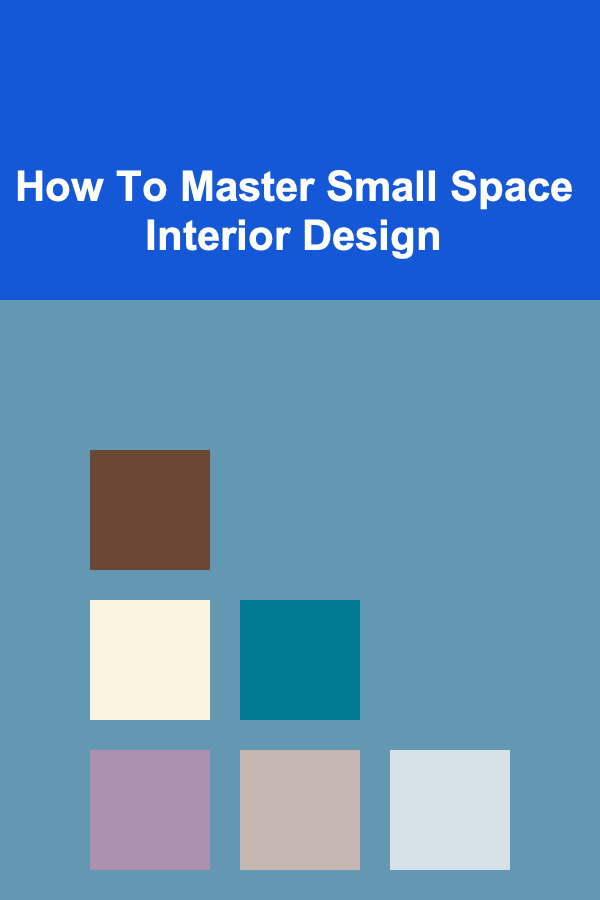
How To Master Small Space Interior Design
ebook include PDF & Audio bundle (Micro Guide)
$12.99$11.99
Limited Time Offer! Order within the next:

Designing a small space can be a challenging but rewarding task. With limited room, every square inch must be thoughtfully considered, and every design choice needs to maximize both style and functionality. Whether you're working with an apartment, a small office, or a compact studio, mastering small space interior design is all about making the most of what you have. This article will guide you through practical techniques, creative ideas, and common pitfalls to avoid, helping you create a space that feels spacious, organized, and stylish.
Understanding the Challenges of Small Space Design
Before diving into specific design strategies, it's important to first understand the challenges you're facing when decorating a small space. These challenges can often seem overwhelming, but recognizing them is the first step toward developing effective solutions.
Limited Square Footage
Small spaces have limited room for furniture, decor, and storage. This can make it difficult to fit everything you need, whether it's a comfortable couch or a desk for work. The key here is efficiency---finding ways to make every item serve multiple purposes without sacrificing style or comfort.
Clutter and Disorganization
A common issue in small spaces is clutter. Without ample storage, things can quickly pile up, making the space feel cramped and chaotic. Staying organized is essential for small space design, which means thinking creatively about storage and choosing furniture that can help with organization.
Creating the Illusion of Space
In a small room, it's easy for the walls to feel like they're closing in on you. Creating the illusion of more space through design techniques is crucial. This can involve color choices, furniture arrangement, lighting, and more.
Maximizing Space with Smart Furniture Choices
When it comes to small space interior design, the furniture you choose plays a pivotal role. Selecting the right pieces is essential for maximizing functionality without sacrificing style.
Multi-Functional Furniture
One of the most effective ways to save space is by using furniture that can serve multiple functions. Here are some ideas:
- Sofa Beds: These pieces offer both seating and sleeping options, making them perfect for a studio or a guest room.
- Extendable Dining Tables: A table that can be expanded when you have guests but shrunk down when you're dining solo.
- Storage Ottomans: These not only provide additional seating but also offer hidden storage for blankets, books, or other items.
- Wall-Mounted Desks: A foldable, wall-mounted desk can turn a corner of a room into a workspace when needed and be tucked away when not in use.
Choose Smaller-Scale Furniture
Another trick is to choose furniture that is appropriately scaled for the size of the room. Large, bulky pieces can overwhelm a small space. Instead, opt for sleeker, more compact furniture. A slim-profile sectional, for instance, is better suited for a small living room than a large, traditional sofa. Likewise, a smaller dining table or minimalist coffee table will allow for more breathing room.
Consider Modular and Custom Pieces
Modular furniture allows you to customize the layout of your space. Modular sofas can be rearranged to suit your needs, and modular shelving units can be stacked or adjusted to create different storage configurations. If your space has unique dimensions, consider custom pieces that can fit perfectly into awkward corners or nooks.
Efficient Storage Solutions
In a small space, storage is a constant challenge. However, with some clever design choices, you can keep clutter at bay and make your space feel organized and functional.
Vertical Storage
When you're limited by floor space, look upwards. Vertical storage takes advantage of unused wall space to store items without taking up valuable floor area. Here are some vertical storage ideas:
- Wall-Mounted Shelves: Floating shelves are ideal for books, plants, or decorative objects. They give the room a minimalist feel while keeping items off the floor.
- Tall Cabinets and Bookshelves: These help maximize vertical space in living rooms, bedrooms, and offices. Ensure that they're not too heavy in design, so they don't dominate the space visually.
- Hanging Baskets: For kitchens and bathrooms, hanging baskets on the wall or from the ceiling can store small items such as towels, utensils, or toiletries.
Hidden Storage
The best way to deal with clutter is to hide it out of sight. Invest in furniture with built-in storage or use creative solutions to tuck things away.
- Under-Bed Storage: Utilize the space under your bed with storage bins or drawers. You can store out-of-season clothing, extra bedding, or shoes.
- Storage Benches: A bench with hidden storage can double as seating and storage, perfect for an entryway or living room.
- Storage Stairs: In a small loft or apartment with stairs, you can create built-in drawers or cabinets underneath the steps for additional storage.
Creative Solutions
Think outside the box with creative storage solutions that integrate seamlessly into your home's design:
- Storage in Furniture: Some coffee tables, for instance, open up to reveal hidden compartments, providing extra storage space.
- Clever Hooks and Pegboards: In kitchens and bathrooms, hooks or pegboards on walls can provide storage for utensils, towels, and even cleaning supplies.
Color Strategies to Create a Sense of Space
Color plays a huge role in how a space feels. In a small room, light, airy colors can help create the illusion of space, while dark colors can make a room feel smaller. Here's how to choose the right colors for your small space:
Light and Neutral Colors
Light shades of whites, beiges, and light grays are excellent choices for small spaces because they reflect light and create a sense of openness. White walls, for example, can make a room feel larger, while light gray or beige can add warmth without making the room feel enclosed.
Accent Walls
If you love bold, dark colors but don't want to overwhelm the space, consider using them on an accent wall. This allows you to introduce drama and depth without making the entire room feel cramped. A rich navy blue, forest green, or charcoal gray wall can create a cozy focal point without taking up too much visual space.
Use of Mirrors
Mirrors are an effective design trick for visually expanding a small space. A large mirror placed strategically can reflect light and create the illusion of more space. Mirrors can be used in living rooms, bedrooms, hallways, or bathrooms, and they work best when paired with other techniques like light colors and open shelving.
Lighting Techniques for Small Spaces
Lighting is another powerful tool in small space design. Proper lighting can make a room feel larger, brighter, and more welcoming, while poor lighting can make it feel cramped and uninviting.
Layered Lighting
Instead of relying on a single overhead light, create a layered lighting scheme with different sources of light. This can include:
- Ambient Lighting: This provides overall light in a room, such as ceiling lights or wall-mounted sconces.
- Task Lighting: Used for specific tasks like reading or cooking, task lighting includes desk lamps, kitchen task lights, or pendant lights over a dining table.
- Accent Lighting: Highlight decorative features or artwork with accent lighting, such as picture lights or floor lamps.
Natural Light
Maximizing natural light is crucial in small spaces. Natural light not only brightens up the space but also makes it feel airy and open. Keep windows unobstructed by heavy curtains or large furniture. Use sheer curtains or blinds that allow light to filter through while still providing privacy.
Use of Light Fixtures
Compact yet stylish light fixtures can add character to small spaces. Consider using pendant lights, wall sconces, or even string lights to add ambiance. These fixtures provide functional light without taking up floor or table space.
Incorporating Personal Style Without Overcrowding
While the goal in a small space is to maximize efficiency, you don't want to compromise on style. Personalize your space with design elements that reflect your tastes while avoiding the temptation to overcrowd the room.
Select Key Decorative Pieces
In small spaces, it's important to limit the number of decorative items. Choose a few key pieces that reflect your personality and taste. This might be a statement art piece, a stylish vase, or a carefully chosen sculpture. These items can add character to the space without overwhelming it.
Use Textiles to Add Warmth
Textiles like throw pillows, rugs, and blankets can add color, texture, and warmth to a small space. Choose fabrics that complement your color palette and add a sense of comfort without cluttering the space.
Personal Touches
Small spaces often benefit from subtle personal touches, like framed photos, plants, or books. These items can infuse the space with personality while also serving functional purposes. For instance, a small collection of books or a few houseplants can add life and charm without taking up too much space.
Avoiding Common Small Space Design Mistakes
While designing a small space, it's easy to make mistakes that can compromise the overall look and functionality of the room. Here are some common pitfalls to avoid:
Overcrowding
One of the most common mistakes is overcrowding the space with too much furniture or decor. In a small room, less is more. Be selective about the pieces you choose and always prioritize functionality and flow.
Ignoring Scale
Choosing furniture that is too large or too small for the space can throw off the balance. Pay attention to the scale of your furniture and ensure it fits comfortably within the space, leaving enough room for movement.
Poor Layout
The layout is critical in a small room. Don't just push all your furniture against the walls in an attempt to maximize floor space. Instead, consider the flow of the room and arrange furniture in a way that encourages easy movement while still feeling cozy.
Conclusion
Mastering small space interior design is about making smart choices and using every inch of space efficiently. With the right furniture, clever storage solutions, thoughtful color choices, and creative lighting, even the tiniest spaces can feel open, airy, and inviting. By understanding the challenges of small space living and implementing these strategies, you can create a home that feels both functional and stylish---no matter how small it is.

How to Design a Functional and Stylish Home Office During Renovation
Read More
How to Save Money on Landscaping and Outdoor Maintenance
Read More
How to Store Towels Efficiently: Folding and Rolling Techniques
Read More
How to Teach Your Kids Financial Responsibility
Read More
How to Master the Art of Persuasion
Read More
How to Price Your Content Writing Services: A Complete Guide
Read MoreOther Products

How to Design a Functional and Stylish Home Office During Renovation
Read More
How to Save Money on Landscaping and Outdoor Maintenance
Read More
How to Store Towels Efficiently: Folding and Rolling Techniques
Read More
How to Teach Your Kids Financial Responsibility
Read More
How to Master the Art of Persuasion
Read More